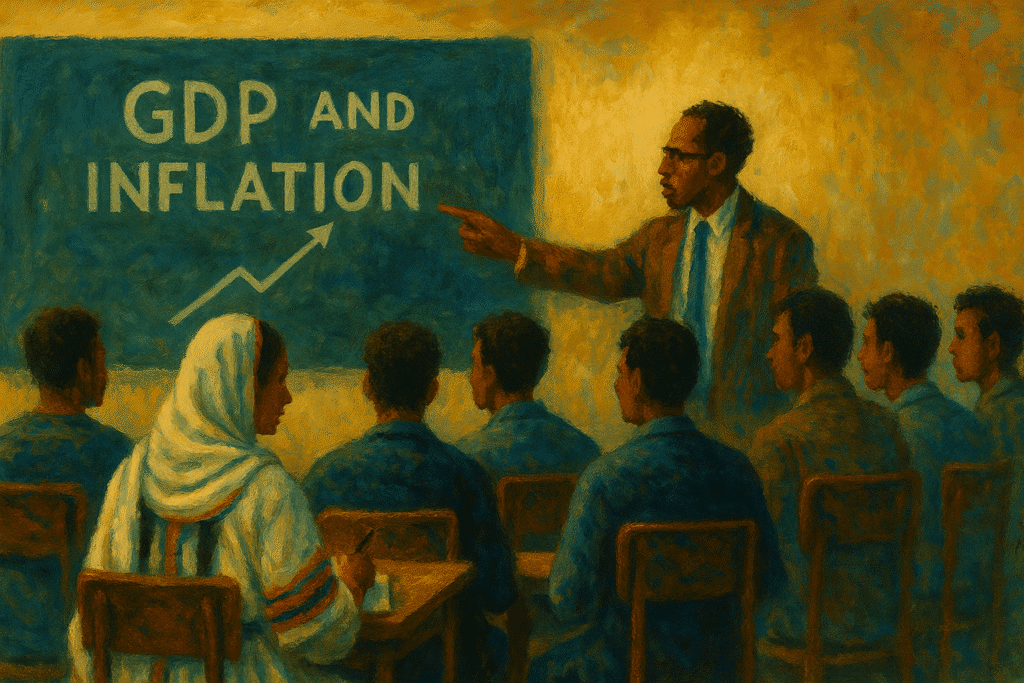The Horn of Africa’s largest economy continues to expand rapidly, yet inflation and conflict have left many Ethiopians struggling to share in that growth.
For much of the past two decades, Ethiopia has stood out as one of Africa’s fastest-growing economies. According to the World Bank, GDP has expanded by around 6–7 percent annually in recent years — a pace that few countries, even globally, have matched. Public investment in infrastructure, manufacturing, and services helped drive the boom, creating new industries and modernizing parts of the economy once rooted in subsistence agriculture.
But the growth numbers conceal a harder reality. Since the Covid-19 pandemic, inflation has averaged above 20 percent, eroding purchasing power and pushing up the cost of food, fuel, and basic goods. The shock has been particularly severe for Ethiopians who live in rural areas, where markets are thin, transport costs high, and incomes heavily dependent on weather-sensitive farming.
Moreover, civil conflicts in the northern regions — most notably the war in Tigray and Amhara — have disrupted trade routes and displaced millions. Combined with droughts and erratic rainfall, these pressures have reversed years of poverty reduction. The World Bank’s Poverty & Equity Brief estimates that the share of Ethiopians living on less than $3 a day climbed from 33 percent in 2016 to nearly 39 percent in 2021, and could edge higher before stabilizing.
Ethiopia’s challenge is not growth itself but ensuring that growth translates into jobs and incomes for its 120 million citizens. The government has responded with a series of macroeconomic reforms aimed at restoring stability and encouraging private-sector participation. These include phasing out fuel subsidies to reduce fiscal strains while incentivizing electric and natural gas vehicles; moving toward a market-based exchange rate to boost competitiveness; adjusting electricity tariffs and overhauling tax and trade rules; and opening strategic sectors such as telecommunications, logistics, and energy to private investment.
Together, these steps mark a gradual shift away from the state-led development model that powered Ethiopia’s early rise. The reforms are designed to attract investment, spur exports, and modernize markets — though the transition has been painful for households coping with higher costs and limited access to credit.
Despite the strain, Ethiopia’s economic fundamentals remain strong. Its large domestic market, youthful population, and position at the crossroads of East African trade give it a strategic advantage. Industrial parks, transport corridors, and new energy projects continue to expand the country’s productive capacity.
Yet the central challenge is creating enough jobs and sustainable incomes for a fast-growing population. More than two million young Ethiopians enter the labor market each year, but formal employment lags behind. Unless productivity in agriculture rises and private industry broadens its reach, inequality between urban and rural areas may widen further.
Ethiopia’s story is one of resilience and readjustment. The economy is growing, investors remain interested, and structural reforms are under way. But persistent inflation, conflict aftershocks, and limited job creation temper the optimism.
Whether Ethiopia can turn its rapid expansion into inclusive growth will depend on how effectively it links reform with opportunity — and whether the promise of its economic boom can finally be felt in the incomes and livelihoods of ordinary Ethiopians.

1 Comment
Though I wouldn’t qualify the current unrest as a full-blown war, the residual effects of past disruptions, coupled with nepotism, corruption, and deliberate economic sabotage, have deeply undermined the benefits of Ethiopia’s growth.
The global economic slowdown only adds pressure, but the root issue remains internal: how to make growth tangible for the majority. Ethiopia’s GDP numbers tell one story, yet the lived reality tells another, where inflation bites, opportunities shrink, and reforms feel too slow to reach the people.
Still, the country’s resilience, strategic position, the awaited private sector’s participation in the economy, and the youth potential give hope. The real test now is whether Ethiopia can turn survival into inclusive progress.